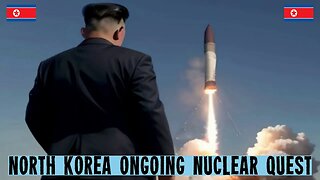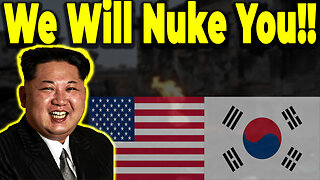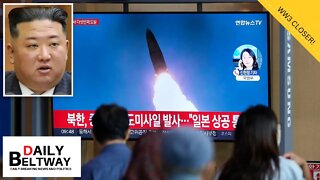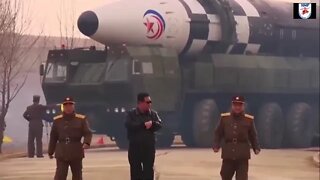Revival of the nuclear arms race? #nuclearweapon #southkoreanuclear #chinanuclear
There is a worrying revival of interest in nuclear weapons. With loose Russian nuclear talk grabbing the headlines of late, North Korea’s military activities have largely gone under the radar. Yet Kim Jong-un’s dogged pursuit of missile and nuclear capabilities continues apace, with “tactical” cruise missile tests in recent weeks, and a seventh nuclear test expected soon – its last test was in 2017.
No magnifying glass is needed to appreciate the dismal state of nuclear politics in Northeast Asia. Yet this was not inevitable. In the 1980s and 1990s, the region was on a restrained nuclear path. Back then, China actively practised the nuclear minimalism it preached, joining deals such as the Nuclear Non-Proliferation Treaty and Comprehensive Test Ban Treaty. US president George H.W. Bush even opted to remove US nuclear weapons from allied Asian soil, including South Korea.
Unfortunately, three decades on, there is a revival of interest in nuclear weapons within Northeast Asia. This revival is clearly visible in China, where a build-up of strategic forces is under way.
The discovery of new missile silo bases last year, the mass development of dual-use missiles (for nuclear or conventional strikes) such as the DF-26, coupled with hypersonic capabilities and nuclear-armed submarines showcase an unprecedented level of military options for decision-makers in Zhongnanhai. The virtues of minimalism and nuclear restraint seem to be fading fast for China’s strategic community and Communist Party elites.
Beyond new technology, a less-well-documented discovery is that the domestic narrative around the atomic bomb is changing. Once of little public interest, the scientific story of China’s nuclear weapons program is now enthusiastically commemorated by the Communist Party.
President Xi Jinping has had a hand in shaping public consciousness, for instance by celebrating “strategic scientists”, like the late Qian Xuesen who was pivotal to China’s missile programme. While previous leaders such as Deng Xiaoping and Jiang Zemin have sometimes linked China’s nuclear arsenal to a national sense of greatness, Xi goes further.
In December 2015, for example, China’s nuclear forces were elevated in status – the Second Artillery Corps was renamed the PLA Rocket Force and upgraded from an independent branch to a full military service – and their significance for China’s great power status reaffirmed. Soap operas and Chinese media now frequently glorify China’s nuclear achievements, from those by strategic scientists to rapid jumps such as the development of atomic (1964) and hydrogen (1967) capabilities under Mao Zedong.
In essence, nuclear commemoration bolsters a wider political narrative around China’s national rejuvenation and greatness that has become a hallmark of Xi’s leadership.
South Korea is also witnessing a nuclear revival of sorts. On the one hand, the active pursuit of an indigenous conventional “strategic strike system” – which includes submarine-launched ballistic missiles and hypersonic cruise missiles, as well as missile defence systems – is intended to counter the growing security threat posed by North Korea.
On the other hand, South Korea continues to rely on extended deterrence from the American nuclear umbrella, though there have been concerns over the credibility of this nuclear promise for decades.
====================================
We appreciate all of our viewers and supporters. Thank you.
====================================
Support us on Patreon: https://www.patreon.com/shieldwalldefense
====================================
Fair use is the right to use a copyrighted work under certain conditions without permission of the copyright owner. The doctrine helps prevent a rigid application of copyright law that would stifle the very creativity the law is designed to foster. It allows one to use and build upon prior works in a manner that does not unfairly deprive prior copyright owners of the right to control and benefit from their works. Together with other features of copyright law like the idea/expression dichotomy discussed above, fair use reconciles the copyright statute with the First Amendment.
====================================
-
 8:35
8:35
ShieldWall Defense
1 year agoThe coming nuclear weapons state - South Korea #southkorea #nuclearweapon
31 -
 3:46
3:46
ShieldWall Defense
10 months agoThe Rising Threat - North Korea's Ongoing Nuclear Quest #northkorea
95 -
 0:38
0:38
Gen Z News
1 year agoNorth Korea Ushers in a New Era of Strategic Weapons: High-Thrust Solid-Fuel Motor Test #shorts
8 -
![The North Korean [DPRK] NUCLEAR MISSILE program escalates with CCP DF17 missiles now in play!](https://hugh.cdn.rumble.cloud/s/s8/1/P/s/x/n/Psxnl.0kob-small-The-North-Korean-DPRK-NUCLE.jpg) 59:41
59:41
The Unspoken Truth
10 months agoThe North Korean [DPRK] NUCLEAR MISSILE program escalates with CCP DF17 missiles now in play!
212 -
 7:10
7:10
GeopoliticalTrends
3 months agoNorth Korea is Not Bluffing!
1.43K4 -
 2:12
2:12
DiggTrueInfor17
1 year agoUS sends bombers up as North Korea New Missile Test
441 -
 57:23
57:23
The Memory Hole
5 months agoThe Latest Designated Enemy: Perspectives on North Korea's Nuclear Program (1994)
1.33K2 -
 15:58
15:58
Breaking News
1 year agoWAR! EMERGENCY ALERT! NORTH KOREA FIRES 10 MISSLES S. KOREA SCRAMBLES JETS FIRES BACK
571 -
 5:00
5:00
Newsmilitary
1 year agoWhy does North Korea fires ballistic missile over Japan.
26 -
 10:48
10:48
The Memory Hole
1 year agoCIA Archives: Biological Warfare in the Korean War (1952)
2.15K1